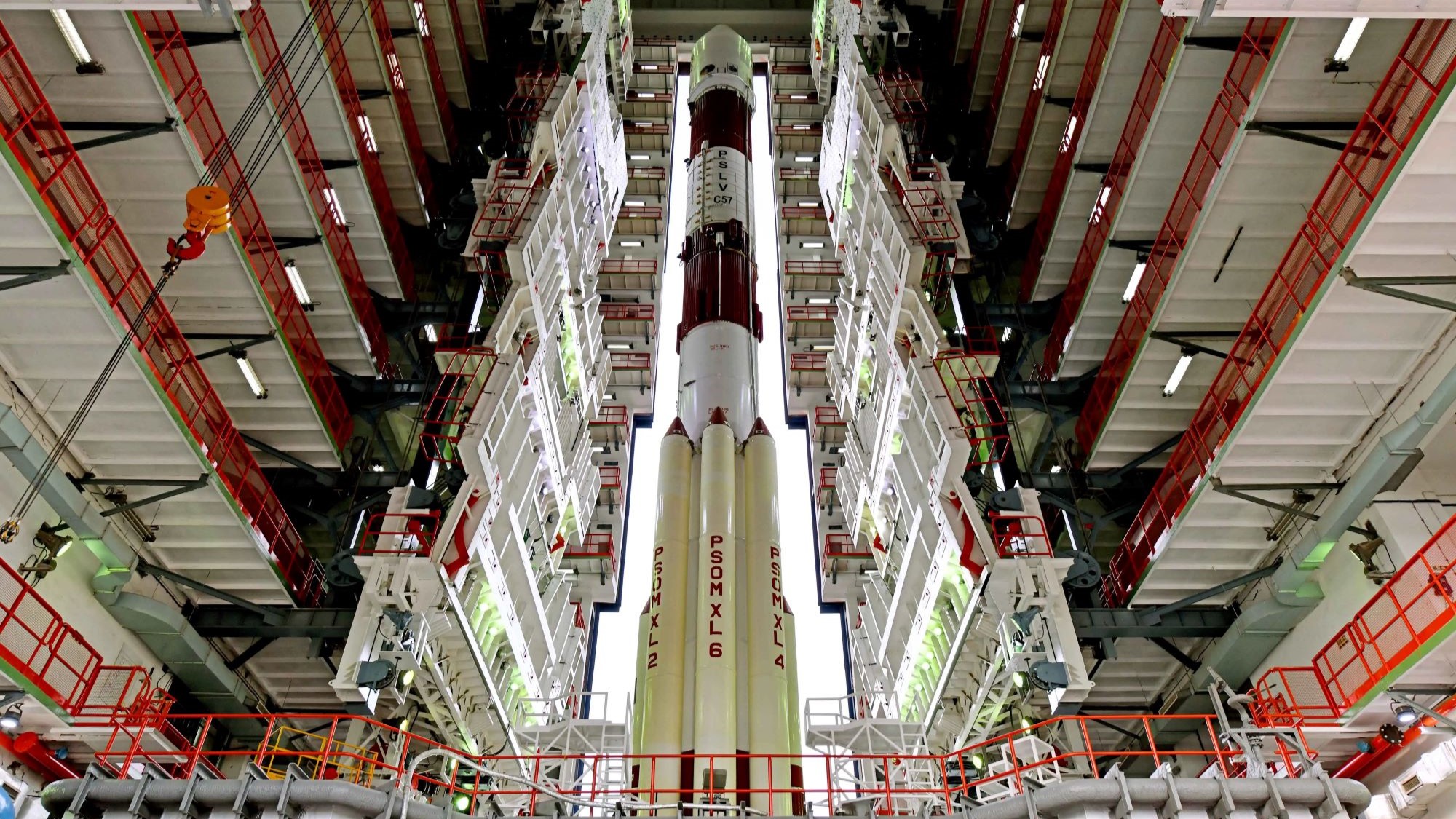

Update (September 5, 2023): India successfully launched its Aditya-L1 solar observatory on September 2 at 2:20 am EST. It is expected to arrive at its first destination between the Earth and the sun in January 2024.
On August 23, the Indian Space Research Organization (ISRO) pulled off the Chandrayaan-3 mission, depositing the Vikram lander and Pragyan rover near the lunar South Pole. India is now the fourth nation to land on the moon—following Russia, the US and China— and the first to land near the lunar South Pole, where the rover has already detected sulfur and oxygen in the moon’s soil. Fresh off of this success, ISRO already has another mission underway, and its next target is something much bigger—the sun.
The ISRO’s Aditya-L1 spacecraft, armed with an array of sensors for studying solar physics, is scheduled to launch around 2 a.m. Eastern on September 2, atop a PSLV-C57 rocket from the Satish Dhawan Space Center in Sriharikota, in southeast India.
Aditya-L1 will begin a four-month journey to a special point in space. About 932,000 miles away is the sun-Earth L1 Lagrangian, an area where the gravity of Earth and the sun cancel out. By entering into an orbit around L1, the spacecraft can maintain a constant position relative to Earth as it orbits around the sun. It shares this maneuver with the NASA-ESA Solar and Heliospheric Observatory, or SOHO, which has been in the sun-observation business since 1996. If it reaches the L1 orbit, Aditya-L1 will join SOHO, NASA’s Parker Solar Probe, ESA’s Solar orbiter, and a handful of other spacecraft dedicated to studying the closest star to Earth.
“This mission has instrumentation that captures a little bit of everything that all of these missions have already done, but that doesn’t mean we’re going to replicate science,” says Maria Weber, a solar astrophysicist at Delta State University in Mississippi, who also runs the state’s only planetarium at that campus. ”We’re getting more information and more data now at another time, a new time in the solar cycle, that previous missions haven’t been able to capture for us.” The sun undergoes 11-year patterns of waxing and waning magnetic activity, and the current solar cycle is expected to peak in 2025, corresponding with more sunspots and solar eruptions.

Aditya-L1 will carry seven scientific payloads, including four remote sensing instruments: a coronagraph, which creates an artificial eclipse for better study of the sun’s corona, an ultraviolet telescope, and high and low X-ray spectrographs, which can help study the temperature variations in parts of the sun.
[Related: Would a massive shade between Earth and the sun help slow climate change?]
“One thing I’m excited about is the high-energy component,” says Rutgers University radio solar physicist Dale Gary. Aditya-L1 will be able to study high-energy x-rays associated with solar flare and other activity in ways that SOHO cannot. And L1 is a good position for that sort of study, he says, since there is a more stable background of radiation against which to measure solar X-rays. Past measurements made in Earth orbit had to contend with Van Allen radiation belts.
Aditya-L1’s ultraviolet telescope will also be unique, Gary says. It measures ultraviolet light, which has shorter wavelengths than visible light; the shortest or extreme UV light, near the X-ray spectrum, has already been measured by SOHO, but Aditya will capture the longer UV wavelengths.
That could allow Aditya-L1 to study parts of the sun’s atmosphere that have been somewhat neglected, Gary says, such as the transition region between the chromosphere, an area about 250 miles about the sun’s surface, and the corona, the outermost layer of the sun that begins around 1,300 miles above the solar surface and extends, tenuously, out through the solar system.
Although ground-based telescopes can take some measurements similar to Aditya’s, the spacecraft is also kitted out with “in situ” instruments, which measure features of the sun that can only be observed while in space. “It’s taking measurements of magnetic fields right where it’s sitting, and it’s taking measurements of the solar wind particles,” Weber says.
Like all solar physics missions, Aditya-L1 will inevitably serve two overall purposes. The first is to better understand how the sun—and other stars— work. The second is to help predict that behavior, particularly solar flares and coronal mass ejections. Those eruptions of charged particles and magnetic fields can impact Earth’s atmosphere and pose risks to satellites and astronauts. In March 2022, a geomagnetic storm caused by solar radiation caused Earth’s atmosphere to swell, knocking 40 newly launched SpaceX Starling satellites to fall out of orbit.
“We live with this star and so, ultimately, we want to be able to predict its behavior,” Weber says. “We’re getting better and better at that all the time, but the only way we can predict its behavior, is to learn as much as we can even more about it.”
[Related: Why is space cold if the sun is hot?]
Aside from Aditya-L1’s scientific mission, its success will mark another feather in the cap of ISRO, another step in that space agency’s hard work to make India a space power, according to Wendy Whitman Cobb a space policy expert and instructor at the US Air Force School of Advanced Air and Space Studies (who was commenting on her own behalf, not for the US government).
“India has had some pretty expansive plans for the past two decades,” she says. “A lot of countries say they’re going to do something, but I think India is that rare example of a country who’s actually doing it.”
Of course, space is hard. ISRO’s first lunar landing attempt with Chandrayaan-2, in 2019, was a failure, and there’s no guarantee Aditya-L1 will make it to L1. “It’s a technical achievement to go into the correct orbit when you get there,” Gary says. “There’s a learning curve. It would be very exciting if they accomplish their goals and get everything turned on correctly.”
